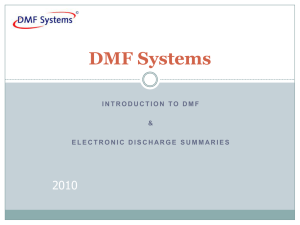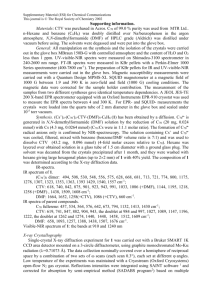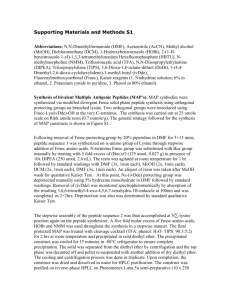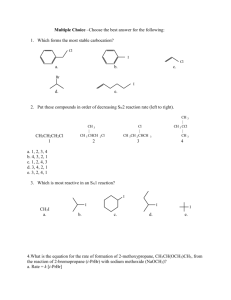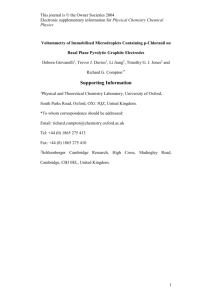Supplementary Information Methods: 1) Molecular Modeling using
advertisement
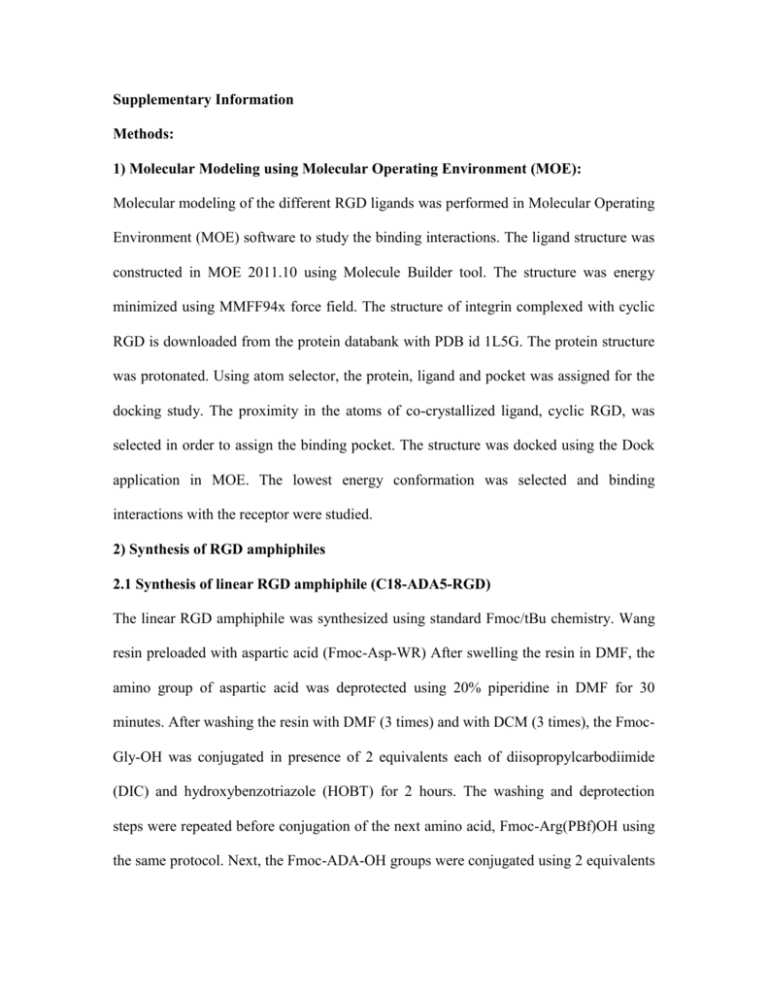
Supplementary Information Methods: 1) Molecular Modeling using Molecular Operating Environment (MOE): Molecular modeling of the different RGD ligands was performed in Molecular Operating Environment (MOE) software to study the binding interactions. The ligand structure was constructed in MOE 2011.10 using Molecule Builder tool. The structure was energy minimized using MMFF94x force field. The structure of integrin complexed with cyclic RGD is downloaded from the protein databank with PDB id 1L5G. The protein structure was protonated. Using atom selector, the protein, ligand and pocket was assigned for the docking study. The proximity in the atoms of co-crystallized ligand, cyclic RGD, was selected in order to assign the binding pocket. The structure was docked using the Dock application in MOE. The lowest energy conformation was selected and binding interactions with the receptor were studied. 2) Synthesis of RGD amphiphiles 2.1 Synthesis of linear RGD amphiphile (C18-ADA5-RGD) The linear RGD amphiphile was synthesized using standard Fmoc/tBu chemistry. Wang resin preloaded with aspartic acid (Fmoc-Asp-WR) After swelling the resin in DMF, the amino group of aspartic acid was deprotected using 20% piperidine in DMF for 30 minutes. After washing the resin with DMF (3 times) and with DCM (3 times), the FmocGly-OH was conjugated in presence of 2 equivalents each of diisopropylcarbodiimide (DIC) and hydroxybenzotriazole (HOBT) for 2 hours. The washing and deprotection steps were repeated before conjugation of the next amino acid, Fmoc-Arg(PBf)OH using the same protocol. Next, the Fmoc-ADA-OH groups were conjugated using 2 equivalents of 2-(1H-7-azabenzotriazol-1-yl)-1,1,3,3-tetramethyl uronium hexafluorophosphate (HATU), 2 equivalents of HOBT and 4 equivalents of N,N-diisopropylethylamine (DIPEA) for 3 hours. Once again, the Fmoc group was cleaved using 20% piperidine in DMF, followed by washing and conjugation of fatty acid was performed by adding 2 equivalents of stearic acid, 2 equivalents of PyBOP (benzotriazol-1-yl- oxytripyrrolidinophosphonium hexafluorophosphate) and 4 equivalents of DIPEA in mixture of DMF and DCM and treatment for 3 hours. The resin was washed and the amphiphile was cleaved from the resin by treating with a mixture of TFA:TIS: H2O (95:2.5:2.5) for 3 hrs. After removal of TFA, the amphiphiles was further precipitated using ether or ether:hexane (50:50) mixture. The solid precipitate of the amphiphile was separated by centrifugation and freeze dried before further analysis. The amphiphile was purified by RP-HPLC for purity >90%. 2.2 Synthesis of cyclic RGD amphiphile (C18-ADA5-c(RGDfK)) Several protocols for synthesis of the cyclic RGD peptide have been reported and modified for improved yields. The protocol for complete on-resin synthesis of the cyclic RGD was modified from the protocol by McCusker et al. The O-allyl protected aspartic acid, Fmoc-Asp-OAll (2.5 equivalents) was loaded on the 2-chloro trityl chloride resin in the presence of 10 equivalents of N,N-diisopropylethylamine (DIPEA) for 5 hours. After washing the resin with DMF (3 times) and DCM (3 times), the amino group was deprotected by treatment with 20% piperidine in DMF for 30 minutes and the wash steps were repeated. The Fmoc-Gly-OH was added in the presence of 2 equivalents of HOBT (hydroxybenzotriazole), 2 equivalents of HATU (2-(1H-7-azabenzotriazol-1-yl)-1,1,3,3tetramethyl uronium hexafluorophosphate) and 4 equivalents of DIPEA. The subsequent amino acids in the order of Fmoc-Arg(Pbf)OH, Fmoc-Lys-Dde and Fmoc-Phe-OH were conjugated using the same deprotection and conjugation protocol. Each conjugation step was performed for 2 hours. Allyl deprotection was performed using chloroform and Nmethylmorpholine in the presence of palladium catalyst in a N2 atmosphere for 4 hours followed by amino group deprotection using 20% piperidine in DMF. Cyclization was carried out overnight in the presence of PyBOP (benzotriazol-1-yl- oxytripyrrolidinophosphonium hexafluorophosphate), DIPEA and DMF. This step was repeated for an additional dioxocyclohexylidene) ethyl 6 hours. Further, the 1-(4,4-Dimethyl-2,6- (Dde) group was specifically cleaved by using 2% hydrazine hydrate in DMF. The 8-amino-3,6 dioxaoctanoic acid (ADA) groups were conjugated to the lysine side chain using the same protocol as for the amino acids. Finally, stearic acid was conjugated in the presence of PyBOP (4 equivalents) and DIPEA (8 equivalents). The amphiphile was cleaved from the resin by treating with TFA:TIS: H2O (95:2.5:2.5) for 3 hrs. After removal of TFA, the amphiphile was precipitated using ether:hexane (50:50) mixture. The amphiphile was then separated by centrifugation and freeze dried before further analysis. The amphiphile was purified by RP-HPLC for purity >90%. Supplemental Table 1: Binding characteristics of different RGD ligands with αvβ3 integrin obtained from molecular modeling using MOE Properties cRGDfK RGD Binding Energy Score -21.8 -5.8 Total Number of Interactions 21 15 FmocNH O OtBut O O O 1) 20% Piperidine in DMF 2) Fmoc-Gly-OH, HOBT, DIC 3) 20% Piperidine in DMF O NH2 HN O OtBut O O O 1) 20% Piperidine in DMF 2) Fmoc-Arg(Pbf)OH, HOBT, DIC 3) 20% Piperidine in DMF O O NH HN H2N NH NH O OtBut O O 1) 20% Piperidine in DMF 2) Fmoc-8-amino-3,6-dioxaoctanoic acid, HATU, HOBT, DIPEA 3) 20% Piperidine in DMF O NH(Pbf) O Repeat n times OtBut O NH NH O NH O O O NH2 n O O NH O HN NH(Pbf) 1) 20% Piperidine in DMF 2) Stearic acid, PyBOP, DIPEA O OtBut O NH O NH O NH O O O O NH CH3 n O NH O HN NH(Pbf) TFA:TIS:Water 95:2.5:2.5 O OH O NH O NH O Supplemental Fig 1: Synthesis nscheme of C18-ADA5-RGD (n=5) O O NH O O NH HN NH2 NH CH3 O O NHFmoc AllO O OAll O Cl Cl O 1) 20% Piperidine in DMF 2) Fmoc-Arg(Pbf)-OH, HATU, HOBT, DIPEA Cl OAll O Cl O O OAll NH O Cl 1) 20% Piperidine in DMF 2) Fmoc-Gly-OH, HATU, HOBT, DIPEA Fmoc-Asp-OAll, DIPEA O NH O O Cl NHFmoc O O O O AllO NH NH HN NH O NH O NH NH(Pbf ) NHFmoc O HN O NH HN 1) 20% Piperidine in DMF 2) Fmoc-Phe-OH, HATU, HN HOBT, DIPEA O NH(Pbf ) HN HN O NH NH O NH(Pbf ) O Cl NHFmoc NH(Dde) O 1) 20% Piperidine in DMF 2) Fmoc-Lys-(Dde)-OH, HATU, HOBT, DIPEA NHFmoc NH(Dde) CHCl3, N-methyl morpholine, Pd(PPh3)4 in inert atmosphere HO HO O O Cl Cl O O O O NH O O NH HN O PyBOP, DIPEA in DMF, 2X treatment (16 hours) NH O HN NH(Pbf ) HN O NHFmoc O NH(Dde) HN O NH 20% Piperidine in DMF NH HN Cl HN O HN O NH O NH NH NH O NH(Pbf ) HN O NH(Dde) O O O N H O H2N NH(Dde) Supplemental Fig 2: Scheme for on-resin synthesis of cRGDfK NH NH(Pbf ) O O Cl Cl O O O H N O H N O NH O NH O O O HN O HN 2% hydrazine hydrate in DMF NH NH O O NH NH O O NH NH NH NH NH(Pbf) NH(Pbf) NH2 NH(Dde) Repeat n times 1) Fmoc-8-amino-3,6-dioxaoctanoic acid, HATU, HOBT, DIPEA 2) 20% Piperidine in DMF NH(Pbf) HN NH O O NH NH NH O O NH O NH2 n O O NH O NH O O O Cl Stearic acid, PyBOP, DIPEA NH(Pbf) HN NH O O NH O NH NH O O NH NH CH 3 n O O O NH O NH O O O Cl TFA:TIS:Water 95:2.5:2.5 NH(Pbf) HN NH O NH O O NH NH O O NH O O NH CH 3 n O NH O O HO NH O Supplemental Fig 3: Scheme for on-resin synthesis of C18-ADA5-cRGDfK amphiphile (n=5) P eptidea4 D ata:P eptidea40001.D 96A ug20129:06C al:R efl_Franz1209032A ug201214:51 K ratosP CA xim aC FRV 2.3.4:M odeR eflectron,P ow er:88,P .E xt.@ 1700(bin137) % Int. 1471m V [sum =76509m V ]P rofiles1-52U nsm oothed 1337.9 100 90 80 1339.9 70 60 1165.9 50 1166.9 40 30 20 10 0 600 800 1000 1200 1400 M ass/C harge 1600 1800 1[c].D9 2000 Supplemental Fig 4: MALDI spectrum of C18-ADA5-RGD amphiphile showing molecular ion peak n z 1 2 0 9 0 3 1 7 M a y 2 0 1 3 1 5 :3 4 8 5 ,P .E x t.@ 2 0 6 7 (b in 1 5 1 ) 1[c].K12 U n s m o o th e d 1 5 9 4 .9 1 5 9 6 .9 1 5 0 0 2 0 0 0 M a s s /C h a rg e 2 5 0 0 1[c].K12 3 0 0 0 Supplemental Fig 5: MALDI spectrum of C18-ADA5-cRGDfK amphiphile showing molecular ion peak 1 2 0 9 0 3 2 4 J a n 2 0 1 3 1 5 :2 6 6 9 ,P .E x t.@ 1 1 8 1 ( b in 1 1 4 ) 1[c].C4 U n s m o o th e d 1 2 0 3 .0 1 2 0 4 .0 1 2 1 9 .0 1 2 0 0 1 4 0 0 M a s s /C h a r g e 1 6 0 0 1 8 0 0 1[c].C4 2 0 0 0 Supplemental Fig 6: MALDI spectrum of C18-ADA5-GGG amphiphile (sodium adduct peak at m/z of 1203) 0.85 0.8 0.75 0.7 I3/I1 0.65 0.6 0.55 0.5 -3 -2 -1 0 1 log concentration (μM) 2 3 Supplemental Fig 7: CMC plot of I3/I1 ratio of pyrene v/s concentration of C18-ADA5RGD amphiphile 0.7 0.68 0.66 0.64 I3/I1 0.62 0.6 0.58 0.56 0.54 0.52 0.5 -3 -2 -1 0 1 log concentration of amphiphile (μM) 2 3 Supplemental Fig 8: CMC plot of I3/I1 ratio of pyrene v/s concentration of C18-ADA5cRGDfK amphiphile 0.8 0.75 0.7 I3/I1 0.65 0.6 0.55 0.5 -3 -2 -1 0 log concentration of amphiphile (μM) 1 2 Supplemental Fig 9: CMC plot of I3/I1 ratio of pyrene v/s concentration of C18-ADA5GGG amphiphile 1.2 1 0.8 C18-ADA5-GGG ln (I0/I) 0.6 C18-ADA5-RGD C18-ADA5-cRGDfK 0.4 0.2 0 0 1 2 3 [Q] micromolar Supplemental Fig 10: Plot of ln(I0/I) for pyrene v/s increasing concentration of the quencher for determination of aggregation number of different amphiphiles Supplemental Table 2: Difference in tumor inhibition with respect to control at study endpoint Treatment % Tumor Inhibition with respect to control at End Point of the Study Taxol 50 μg/kg twice weekly 28.2 PTX-RGD micelles 50 μg/kg twice weekly 61.8 Taxol 50 μg/kg every alternate day 51.4 PTX-RGD micelles 50 μg/kg alternate day 68.9
